Bowflex Blaze User Manual

™
PN 001-6902 Rev B (8/2006)

Table of Contents
Safety Requirements |
5 |
Safety Warning Labels |
7 |
Get to Know Your Machine |
10 |
How to Use Your Machine |
11 |
Power Rod® Resistance |
11 |
Adjusting/Understanding The Resistance |
11 |
Hooking Power Rod® Unit to Cables |
11 |
Safety |
11 |
When You Are Not Using Your Gym |
11 |
How to Use Your Machine |
12 |
The Workout Bench |
12 |
Removing the Bench |
12 |
Flat Bench |
12 |
45° Incline Bench |
12 |
Leg Extension |
12 |
Free-Sliding Seat |
12 |
Storing Your Bowflex® Blaze™ Home Gym |
12 |
Maintenance and Care |
12 |
How to Use Your Machine |
13 |
Accessories and Equipment |
13 |
Using Your Leg Press Belt and |
|
Squat Bar Pulleys |
14 |
Define Your Goals |
16 |
Warm Up / Cool Down |
17 |
Chest Exercises |
18 |
Shoulder Horizontal Adduction |
18 |
Bench Press |
18 |
Decline Bench Press |
19 |
Incline Bench Press |
19 |
Decline Chest Fly |
20 |
Incline Chest Fly |
20 |
Resisted Punch |
21 |
Lying Cable Crossover |
21 |
Shoulder Exercises |
22 |
Rear Deltoid Rows |
22 |
Standing Lateral Shoulder Raise |
22 |
Seated Shoulder Press |
23 |
Front Shoulder Raise |
23 |
Shoulder Extension |
24 |
Shoulder Shrug |
24 |
Scapular Protraction |
25 |
Scapular Depression |
25 |
Lying Front Shoulder Raise |
26 |
Reverse Fly |
26 |
Shoulder Rotator Cuff |
27 |
Shoulder Rotator Cuff |
27 |
Seated Lateral Shoulder Raise |
28 |
Scapular Retraction |
28 |
Back Exercises |
29 |
Lying Lat Pulldowns |
29 |
Low Back Extension |
29 |
Pulldowns |
30 |
Narrow Pulldowns with Handgrips |
30 |
Lying Lat Fly |
31 |
Lying Narrow Lat Pulldowns |
31 |
Seated Lat Rows |
32 |
Stiff-Arm Pulldown |
32 |
Bent Over Row |
33 |
Arm Exercises |
34 |
Triceps Pushdown |
34 |
Single Arm Pushdown |
34 |
French Press |
35 |
Lying Triceps Extension |
35 |
Cross Triceps Extension |
36 |
Lying 45o Triceps Extension |
36 |
Seated Triceps Extension |
37 |
Standing Biceps Curl |
37 |
Seated Biceps Curl |
38 |
Lying Biceps Curl |
38 |
Seated Wrist Extension |
39 |
Standing Wrist Curl |
39 |
Reverse Curl |
40 |
Seated Wrist Curl |
40 |
Standing Wrist Extension |
41 |
“Rope” Pushdown |
41 |
Abdominal Exercises |
42 |
Reverse Crunch |
42 |
Resisted Reverse Crunch |
42 |
Seated (Resisted) Ab Crunch |
43 |
Seated (Resisted) Oblique Ab Crunch |
43 |
Trunk Rotation |
44 |
Leg Exercises |
45 |
Leg Extension |
45 |
Squat |
45 |
Lying Leg Extension |
46 |
Ankle Eversion |
46 |
Ankle Inversion |
47 |
Standing Hip Extension |
47 |
Standing Hip Extension |
48 |
Standing Hip Abduction |
48 |
Seated Hip Adduction |
49 |
Seated Hip Abduction |
49 |
Standing Leg Kickback |
50 |
Leg Press |
51 |
Prone Leg Curl |
52 |
Muscle Chart |
53 |
US Warranty Information |
54 |
Bowflex Body Leanness Program |
57 |
The Workouts |
66 |
Contact Information |
77 |
3
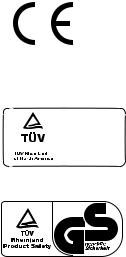
Product Specifications:
Product Weight |
195 lbs. |
(88 kg) |
Product Dimensions |
90" L x 38" W x 83" H (229 cm L x 97 cm W x 211 cm H) |
|
Folded Footprint |
52" L x 38" W x 83" H (132 cm L x 97 cm W x 211 cm H) |
|
Workout Area |
100" L x 78" W (254 cm L x 198 cm W) |
|
Number of Exercises |
Over 60 |
|
Power Rod® Resistance |
210 lbs. |
(95 kg) |
Power Rod® Upgradability |
310 lbs. |
(141 kg.) |
|
410 lbs. |
(186 kg.) |
User Weight Limit |
300 lbs. |
(136 kg) |
|
|
|
Regulatory Approvals:
Meets:
EN957-1 Class H
EN957-2 Class H
Meets:
ASTM F2276-05
ASTM F2216-05
4

Safety Requirements
IMPORTANT SAFETY INSTRUCTIONS
The following definition applies to the word “Warning” found throughout this manual:
|
Used to call attention to POTENTIAL hazards that could |
|
result in personal injury or loss of life. |
||
|
READ ALL INSTRUCTIONS
BEFORE USING THE MACHINE.
•Always read and follow the Warning and Safety labels attached to your Bowflex® Blaze™ home gym. Do not remove these labels. If you need replacement labels, please call a Nautilus Representative at 1- 800-NAUTILUS (628-8458).
•Read the owner’s manual and follow it carefully before using the machine.
•Parents and others in charge of children should be aware of their responsibility, because the natural play instinct and the fondness for experimenting of children can lead to situations and behavior for which the training equipment is not intended.
•Never allow children to use the Bowflex® Blaze™ home gym unsupervised. To do so could result in injury. If children are allowed to use the equipment, their mental and physical development should be taken into account. They should be controlled and instructed on the correct use of the equipment.
•This equipment is under no circumstances suitable as a children’s toy.
•Inspect your machine for any worn or loose components prior to use. Tighten or replace any worn or loose components prior to use. Pay close attention to cables, or belts and their connections.
•Never use dumbbells or other weight equipment to incrementally increase the weight resistance. Use only the Power Rod® unit that came with your Bowflex® Blaze™ home gym.
•Set up and use your Bowflex® Blaze™ home gym on a hard, level surface.
•Do not wear any loose or dangling clothing or jewelry while using the Bowflex® Blaze™ home gym. Stand clear of all moving components.
•Before beginning any exercise program consult your physician or health care professional. Only he or she can determine the exercise program that is appropriate for your particular age and condition. If you experience any light-headedness, dizziness, or shortness of breath while exercising, stop the exercise and consult your physician.
•This machine is meant for individual consumer use only, and is not meant for use by institutions.
•Maximum user weight for the Bowflex® Blaze™ home gym is 300 pounds (136 kg). For your safety, do not use or allow others to use the Bowflex® Blaze™ home gym if they weigh in excess of 300 pounds (136 kg).
•Allow a workout area of at least 8’4” L x 6’6” W(2.6 m x 2 m) of free space for safe
5

Safety Requirements
operation of the Bowflex® Blaze™ home gym.
•Keep your body weight centered on the machine, seat, or base frame platform while exercising.
•When using the Bowflex® Blaze™ home gym for standing leg exercises, always grasp the Lat Tower on your machine for stability.
•Keep out of the path of the Power Rod® unit when exercising and make certain that observers also stand clear of the Bowflex® Blaze™ home gym when the Power Rod® unit is in use.
•Never move or adjust the seat while sitting on it. Never stand on the seat.
•When hooking up Power Rod® caps, do not stand directly looking over the top of the rods. Stand off to the side while attaching rods.
•Never attempt to exercise with more resistance than you are physically able to handle.
•Keep cables and Power Rod® unit bound with the rod binding strap when not in use.
•Before exercising, make sure the cable pulley system is properly secured, properly attached, and in perfect working condition.
6
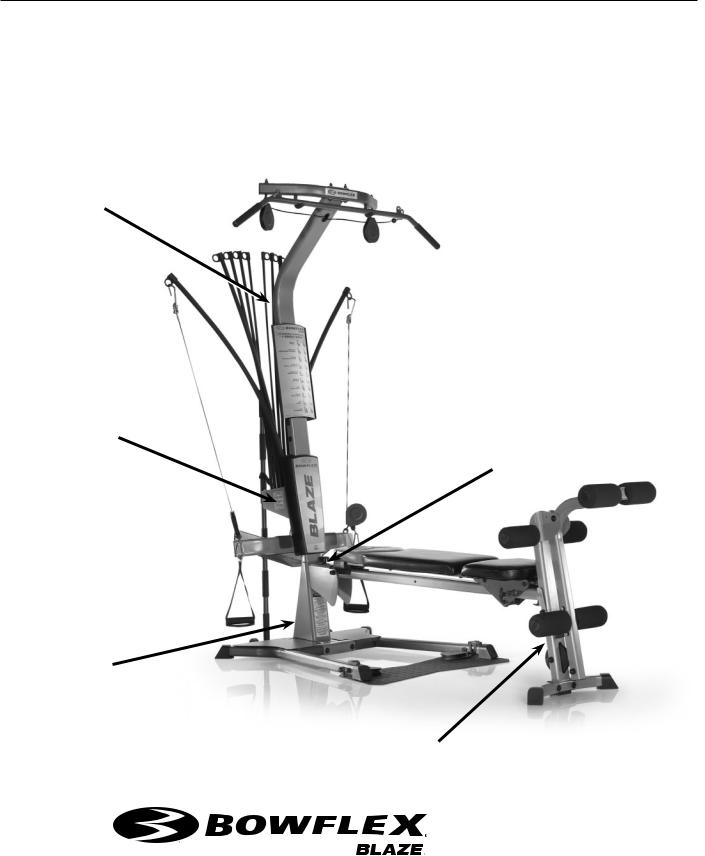
Safety Warning Labels
The following safety warnings are located on the Bowflex® Blaze™ exercise machine. Please read all safety precautions and warning information prior to using your product. Be sure to replace any warning label if damaged, illegible, or missing. If you need replacement labels, please call a Nautilus Representative at 1-800-NAUTILUS (628-8458).
Label 1
Label 2
Label 3
Label 5
Label 4
Home Gym
7
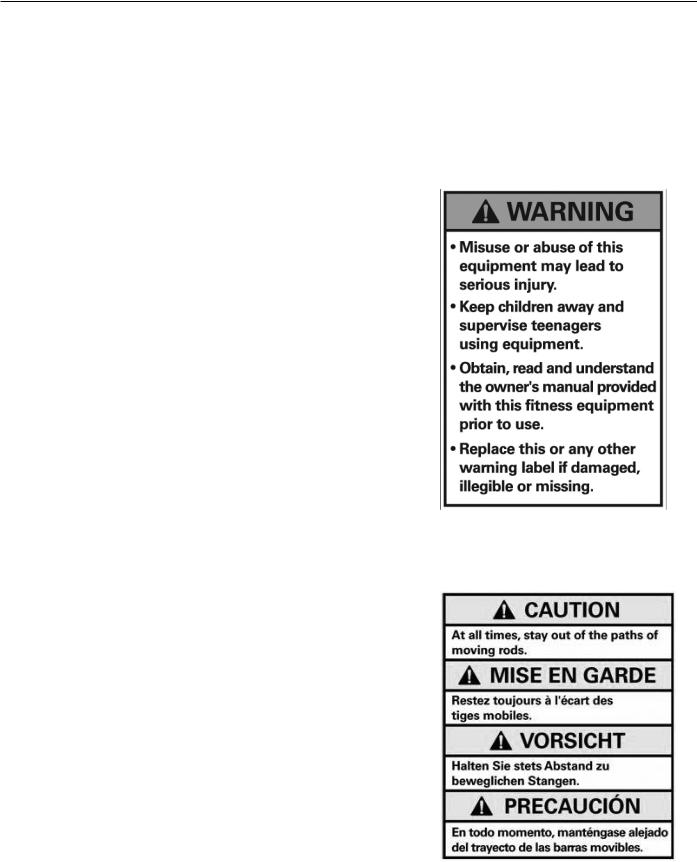
Safety Warning Labels
The following safety warnings are located in site specific areas on the unit. Please review and understand the safety warning labels and their locations on the unit prior to use.
If you do not have, or cannot find, or need to replace a warning label please call 1-800-NAUTILUS (1-800-628-8458) to obtain a new label.
Label 1: Please make sure all users read, understand, and follow the warning labels on the home gym. See Figure 1 for general use safety label.
Location: The warning label in Figure 1 is located on the back of the lat tower.
Label 2: See figure 2 for “Caution” safety label.
Location: Left and right side of rod box.
Figure 2
8

Safety Warning Labels
Label 3: See Figure 3 for “Caution” safety label. Avoid crush hazard when folding the bench.
Location: Top of the seat rail bracket.
Figure 3
Label 4: See Figure 4 for “Caution” safety label. Stay clear of the leg when folding the leg extension.
Location: Back of rear leg of leg extension.
Figure 4
Label 5: See Figure 5 for “Caution” safety label.
Location: Back of the lower lat tower, below chest bar.
Figure 5
9
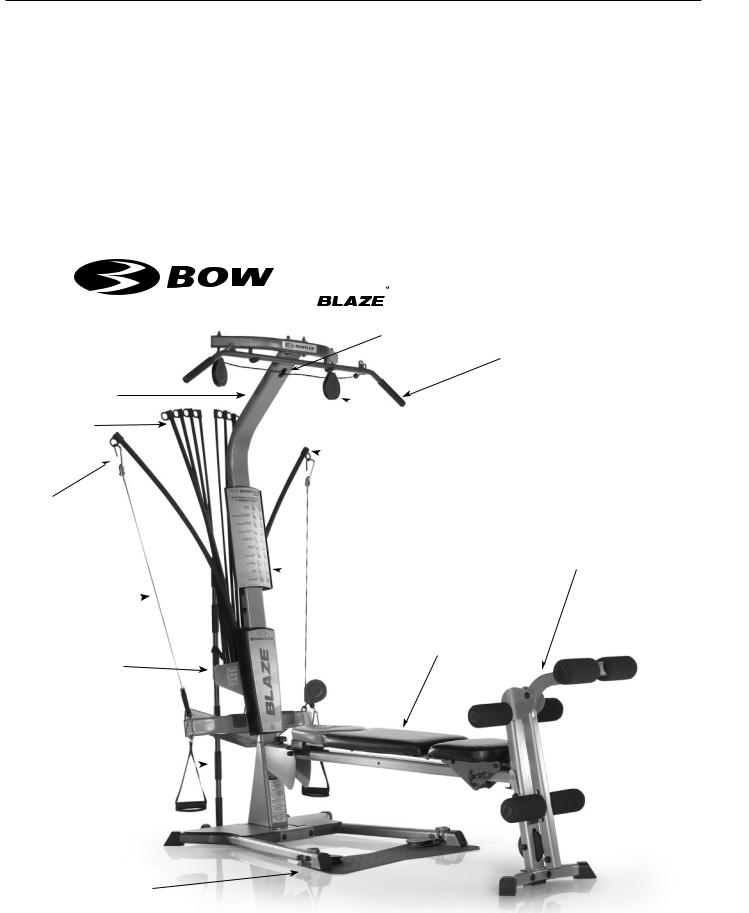
Get to Know Your Machine
CONGRATULATIONS on your commitment to improving your health and fitness! With the Bowflex® Blaze™ home gym, you have everything you need to exceed all of your physical fitness, strength and health expectations!
The Bowflex® Blaze™ home gym’s exceptional resistance and quality is unmatched by any other single piece of home fitness equipment available. You will not believe the amazing results your body will get with the Bowflex® Blaze™ home gym!
Please take your time to read through the entire manual and follow it carefully before attempting to use your
Bowflex® Blaze™ home gym. Also locate and read all warning labels that are posted on the machine. It’s important to understand how to properly perform each exercise before you do so using Power Rod® Resistance.
With all of the fitness choices available today, finding the best workout equipment for your needs can be very confusing. Everyone at Nautilus would like to thank you for selecting the Bowflex® Blaze™ home gym.
Bowflex® Blaze™ home gym is the finest home fitness product available, and you’re just about to prove it to yourself.
Upper
Lat Tower
Power Rod®
Unit
Rod Hook
Cable 
Rod Box
Chest Bar 
Pulley
Squat Bar 

 HomeGym
HomeGym
Lat Cable Storage
Bent Lat Bar
 Lat Bar Pulley
Lat Bar Pulley
 Rod Caps
Rod Caps
Leg Attachment
 Workout Placard
Workout Placard
Bench
Squat Platform
and Pulleys
10
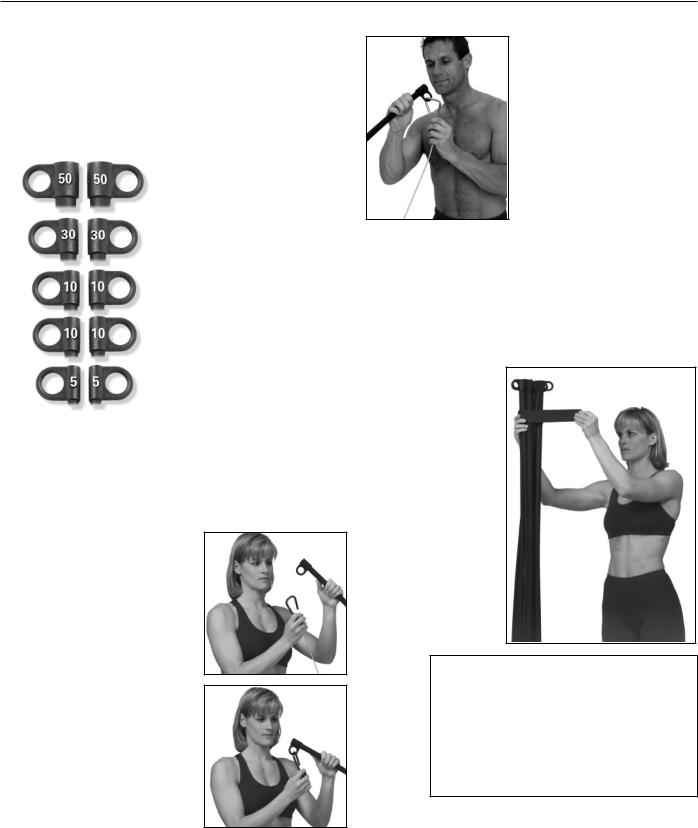
How to Use Your Machine
Power Rod® Resistance
Power Rod® rods are made from a special composite material. Your rods are sheathed with a protective black rubber coating. Each rod is marked with its weight rating on the “Rod Cap”.
Adjusting And
Understanding
The Resistance
The standard Bowflex® Blaze™ home gym comes with 210 pounds (95 kg) of resistance (one pair of 5 lb. (2.25 kg) rods, two pair of 10 lb. (4.5 kg) one pair of 30 lb. (13.5 kg) rods, and one pair of 50 lb. (22.5 kg) rods).
If you upgraded to a 310 lb. (140 kg) or 410 lb. (186 kg) capacity you will have an additional one or two pair of 50 lb. (22.5 kg) rods, respectively.
Hooking the Power Rod®
Unit to the Cables
You may use one rod or several rods in
combination, to create your desired resistance level.
To hook multiple rods up to one cable, bend the closest rod toward the cable and place the cable hook through that rod cap. You can then hook up the next closest rod through the same cable hook.
Hooking up the closest rod first prevents rods from
crossing over the top of one another.
Safety
When hooking the Power Rod® caps to the cable hooks, do not stand directly over the tops of the rods. Stand off to one side when connecting and disconnecting the
Power Rod® unit from the cables.
When You Are Not Using Your Bowflex®
Blaze™ Home Gym
Disconnect the cables from the Power Rod® unit when you are not using your Bowflex® Blaze™ home gym. Use the
rod binding strap included with your machine
to bind all the rods together at the top. You can also place your cables and grips through the strap to keep them out of the way.
To order additional
50 lb. (22.5 kg) Power Rod® sets please call
1-800-NAUTILUS (1-800-628-8458)
11

How to Use Your Machine
The Workout Bench
Your Bowflex® Blaze™ home gym has a number of seat and bench positions: flat bench forward, flat bench back, 45° incline and free-sliding seat extension.
To adjust the seat, pull out the Seat Rail Knob, then slide the seat to one of the three locking holes on the Seat Rail.
Release the Seat Rail Knob to secure when finished.
Removing the Bench:
The Bench easily attaches and releases from the Seat. To attach the Bench, insert the half hinge on the end of the Bench into the half hinge on the seat. To remove the Bench, lift up on the long portion and pull away from seat.
bind the Power Rod® unit with the rod binding strap.
3)Ensure that the Leg Extension Lock-out Pin is installed. (Refer to page A-9 for instructions.)
4)Remove the Seat Rail Knob from the seat rail.
5)Tilt the bench toward the Power Rod® unit.
6)While holding the Rear Leg with one hand, disengage the seat Rail Pull Pin to allow the Rear Leg to fold against the Seat Rail. (See figure 8b on page A-7.)
7)Secure the bench by inserting the Seat Rail Knob into the hole in the side of the Seat Rail Bracket.
Maintenance and Care of Your Bowflex®
Blaze™ Home Gym
Flat Bench:
The Flat bench position is used for most exercises. You may lock the bench into a Back (closest to Power Rod® unit) or Forward (farthest from Power Rod® unit) position to accommodate height/reach needs.
45° Incline Bench:
Start with a flat bench, following the above instructions to release and move the seat and bench. Lift the bench while sliding the seat toward the Power Rod® unit until the bench back is resting against the Lat Tower.
Leg Extension:
Refer to page A-12 of the Assembly Manual for instructions on installing the Leg Extension Seat.
Free-Sliding Seat:
Remove the Bench, pull out the Seat Rail Knob, give it half a turn and release to place the Seat in a “free sliding” position for Aerobic Rowing.
Storing Your Bowflex® Blaze™ Home Gym
Folding your Bowflex® Blaze™ home gym for storage is easy.
1)Lock the Seat and Bench into the flat position.
2)Remove all Power Rod® resistance and then
Inspect your machine for any worn or loose components prior to use. Tighten or replace any worn or loose components prior to use. Pay close attention to cables, or belts and their connections.
Clean the bench with a non-abrasive household cleanser after each use. This will keep it looking new. Do not use automotive cleaner, which can make the bench too “slick.”
Review all warning notices. The safety and integrity designed into a machine can only be maintained when the equipment is regularly
examined for damage and repaired. It is the sole responsibility of the owner to ensure that regular maintenance is performed. Worn or damaged components shall be
replaced immediately or the equipment removed from service until the repair is made. Only manufacturer supplied components shall be used to maintain/repair the equipment.
If you have any questions regarding your Bowflex® Blaze™ home gym, please call our Customer Service Department at 1-800-NAUTILUS (628-8458) or by mail at: 16400 SE Nautilus Dr., Vancouver, Washington, USA 98683.
12

How to Use Your Machine
Accessories and Equipment
Hand Grips: The Hand Grips fit snugly around your hand, ankle, or wrist. Attach the pulley cable clips to the D-Rings on the Hand Grips to attach them to the cables.
Standard Grip: Grasp the grip and cuff together to form a grip without inserting your hand through the cuff portion. Most of the exercises you perform utilize this grip. The Standard Grip also is used for Hammer Grip exercises, when you need to hold the Hand Grip vertically for greater wrist support.
Hand Cuff Grip: Slip your hand through the cuff portion of the grip so that the foam pad rests on the back of your hand. Then grasp the remainder of the grip that is sitting in your palm. This method of gripping is great for exercises like front shoulder raises or any exercise where your palm is facing down.
Ankle Cuff Grip: The cuff opening can be made larger to accommodate the ankle. Place your hand in the cuff and slide it away from the grip. Insert your foot or ankle and tighten by sliding the grip back toward the cuff.
Lat Cross Bar: The Lat Cross Bar enhances exercises that work back, shoulders and triceps muscles.
Safety:
•Before using the Lat Cross Bar, make sure that all fasteners are in place and tightened.
•Make sure that the Lat Tower cables are securely fastened to the regular Bowflex® cables and the Bent Lat Bar, Squat Bar or Hand Grips.
•Always use the Bent Lat Bar holders to support the Bent Lat Bar, or remove the bar when not in use.
•Do not hang from or attempt to perform “chin ups” from the Lat Cross Bar.
•Never pull on the Bent Lat Bar unless there is resistance attached to it.
Leg Extension: Designed to add more effective exercises that target your legs, thighs, calves, etc.
Safety:
•Before using the Leg Extension, make sure that all fasteners are in place and tightened.
•Make sure that the Extension’s cables are securely fastened to the regular cables.
•When installing the Leg Extension Seat always ensure that the Support Tube Bracket Hooks fully engage with the Roller Tube Spacers.
•Always use the supplied Lockout Pin to secure the Leg Extension Pivot Tube to the Rear Leg when not in use.
Accessory Basket: The Accessory Basket, which hooks onto the Chest Bar, provides convenient storage for the Squat Bar and small accessories.
Grips manufactured under license agreement with Hands-On Sports & Gym Accessories, Inc. Patent #4756527
13

How to Use Your Machine
Workout Placard: The Workout Placard, which snaps onto the Lat Tower, displays workout descriptions for easy reference while you’re exercising. Additional workout cards fit easily onto this placard. Simply slide the workout card into the grooves located on either side of the placard.
Using Your Leg Press Belt and Squat Bar Pulleys
Leg Press Belt: The Leg Press Belt is used for the Leg Press exercise.
•With the Bowflex® seat adjusted to the “free sliding” position (spring lock seat pin unlocked), the hand grips removed, and the desired amount of resistance hooked up, sit on the seat and position the leg press belt around your hips.
•Slide forward to the pulleys and place your feet through the right and left openings under the rod cables.
•Attach the rod cables to the D-rings on the Leg Press Belt so that the belt is taut.
•Place hands on vertical main frame and push yourself back while placing feet, one at a time, onto the pulley frame.
•Grasp belt near where it’s attached to the cables and begin to press back.
Squat Bar Pulleys: Used with Squat Harnesses and Squat Bar to perform Squat, Bent Rows and other exercises.
Safety:
•Always check fasteners, hooks, cables and each workout to functioning.
•Remove workout bench and lock seat into closest position to the Power Rod® unit.
•Always wear shoes with non-skid soles when using the Squat Bar Pulleys.
•Fasten each squat cable to a D-ring on each squat harness to the corresponding D-ring on the squat bar using a snap hook.
•You can now add Power Rod® resistance and adjust the squat straps to your height using adjuster buckles.
•Always adjust tension of the squat harness in such a manner that it will not cause a hazard.
14

Define Your Goals
Your body will do what you train it to do. That’s why it’s important to define your goals and focus them. Here are some fitness components that will help you define your goals and choose your fitness program.
Muscle Strength is the maximum force that you can exert against resistance at one time. Your muscle strength comes into play when you pick up a heavy bag of groceries or lift a small child. It is developed when a localized muscle is worked both positively (concentric) and negatively (eccentric) at a resistance—great enough so you can perform only five to eight repetitions of the exercise before the muscle fails. Each set of repetitions is followed by a rest interval that typically runs three times longer than the set. Later, between exercise sessions, the muscle overcompensates for the stress and usually increases in both strength and size.
Muscle Endurance is the ability to perform repeated contractions. It comes into play when you crosscountry ski or work on your feet all day. Endurance training addresses the slow twitch, endurance muscle fibers, which depend on oxygen for energy. To develop muscle endurance, use low resistance and high repetitions about 15-20 repetitions in each set, three sets to each exercise, working the muscle only to fatigue.
Muscle Power is the combination of strength and speed of the muscular contraction. This is often misinterpreted as a) being directly associated with certain skill or sport and/or b) meaning that you must move fast. Load is actually a more important factor than speed when attempting to
improve power. When training to achieve muscular power, pick a resistance that fatigues you in the 3- 5 repetition range. When performing these reps, it is more important to think of contracting the
muscles faster rather than attempting to move faster. Performing sport simulation exercises usually results in a deterioration of the motor pattern or skill. The biomechanically sound method of improving power in your sport is to train for power using the correct joint movements, as described in this manual. Then practice the skill associated with your sport, learning to apply this newly achieved power.
Body Composition is the ratio of fat weight (fat) to lean weight (muscles, bones and tissue). As you age, the ratio shifts. The fat weight increases and the lean weight decreases. Training for muscle strength will generally increase muscle size and aerobic conditioning will help burn extra calories. Performing these two forms of exercise, either at different times or together, will create the greatest changes in body fat weight.
Balanced Strength and alignment are the result of equal strength developed in all parts of the body. It comes into play in your standing and sitting posture, and in your ability to perform just about any activity safely and effectively. An over-development of the back will round the shoulders; weak or stretched abdominals can cause lower back pain. You want
a balance of muscle strength in front and back. In addition, you need a balance of strength between your middle, lower, and upper body.
Flexibility is the ability of a muscle or group of muscles to move the joint through a full range of motion. Flexibility comes into play when you execute an overhand serve or stretch for the top
shelf in the kitchen. It is a cooperative movement of opposite muscle groups. When a muscle contracts, its opposite muscle group must relax for the action to occur. Increased flexibility means an increased range of motion, made possibly by this simultaneous contracting and relaxing. Good flexibility is important in protecting the body from injury and can be achieved through the balanced strength training programs that are included in this manual.
Cardiovascular Endurance is the ability of the heart and lungs to supply oxygen and nutrients to exercising muscles over an extended period of time. It comes into play when you jog a mile or ride a bike. It is a critical component of overall fitness and health.
15

Define Your Goals
Design Your Own Program
You may want to design your own personal program specifically geared to your goals and lifestyle. Designing a program is easy, as long as you follow the guidelines below.
Understand fitness and its components:
Improperly designed programs can be dangerous. Take some time to review this manual as well as other fitness guides.
Know your current fitness level: Before you start any fitness program you should consult a physician who will help you determine your current abilities.
Identify your goals: Goals are critical to choosing and designing an exercise program that fits and enhances your lifestyle, but so is strategy. It’s important not to rush the process and try to accomplish too much too soon. That will lead to setbacks and discouragement. Instead, set a series
of smaller achievable goals.
Select complementary exercises: Be sure to pair exercises that address compound joint movements and single joint movements.
In addition, select exercises that address complementary muscle groups.
Put first things first: During each session, first work muscle groups that need the most training.
Remember your cardiovascular component: Any fitness program must contain a cardiovascular fitness component to be complete. So complement your resistance training with aerobic exercise such
as walking, running, or bicycling.
Training variables: When designing your own program there are several variables that, when mixed properly, will equal the right fitness formula for you. In order to find out the best formula, you must experiment with several combinations of variables.
The variables are as follows:
•Training Frequency: The number of times you train per week. We recommend daily activity but not daily training of the same muscle group.
•Training Intensity: The amount of resistance used during your repetition.
•Training Volume: The number of repetitions and sets performed.
•Rest intervals: The time you rest between sets and the time you rest between workouts.
Once you’ve established a base of fitness, follow these basic principles:
•Isolate muscle groups: Focus work on specific muscle groups.
•Progressive Loading: The gradual systematic increase of repetitions, resistance and exercise period.
16

Define Your Goals
Working Out
A workout begins in your mind’s eye. With concentration and visualization, you can approach your workout with a positive, constructive attitude. A good pre-workout mental routine is to sit and relax so that you can focus on what you are about to do and think about achieving your end goal.
Warming Up
We recommend that you warm up by doing light stretching and performing light exercises on the Bowflex® Blaze™ home gym.
Cooling Down
An essential part of the exercise routine is the cool down. Gradually reduce the level of exercise intensity so that blood does not accumulate in one muscle group but continues to circulate at a decreasing rate. Remember to gradually move yourself into a relaxed state.
Breathing
The most important part of breathing during exercise is, quite simply, that you do it. Breathing in or out during the actual performance is not dependent upon the direction of air flow relative to exertion. It is, in fact, a mechanical process that changes the position of your spine as your rib cage moves. Here are some tips for breathing:
1)Be cautious when you are concentrating or exerting effort. This is when you will probably hold your breath. DO NOT hold your breath. Do not exaggerate breathing. Depth of inhalation and exhalation should be natural for the situation.
2)Allow breathing to occur naturally; don’t force it.
Warm Up / Cool Down
Aerobic Rowing—Warm Up or Cool Down
Muscles Worked:
Pectoralis Major, Latissimus Dorsi,
Anterior Deltoids, Quadriceps, and
Hamstrings
Bench Position:
Removed, Free Sliding Seat
Accessory:
Handgrips
Pulleys:
Chest Bar
SuccessTips
•Maintain good spinal alignment. Keep chest lifted.
•Bend from the hip during movement, not from the waist.
START
Start
•Remove the Bench, and place the Seat in the free-sliding position.
•Attach resistance, and sit facing the Power Rod® unit.
•Brace your feet against the Chest Bar.
FINISH
Action
•Initiate movement by extending your knees while simultaneously bending your arms and pinching your shoulder blades together.
•Control the return to the Start position by slowly bending your legs.
17

Chest Exercises
Chest Fly—Shoulder Horizontal Adduction (elbow stablized)
Muscles Worked:
Pectoralis Major and Anterior Deltoid
Bench Position:
45o incline
Accessory:
Handgrips
Pulleys:
Chest Bar
SuccessTips
•Maintain a 90-180o angle between your arms and torso during the exercise.
•Keep your chest muscles tightened. Limit and control your range of motion.
•Keep your knees bent, feet on floor, and your head back against the Bench.
•To improve your pectoralis involvement, keep your shoulder blades pinched together throughout the upward and downward movements.
START
Start
•Grasp the Handgrips in both hands.
•Open your arms into a wide position while maintaining a bend in your elbows. Start with your elbows and forearms below chest level, palms forward.
•Raise your chest, pinch shoulder blades together, and maintain a slight, comfortable arch in lower back.
FINISH
Action
•Maintaining the slight bend in your elbow, slowly bring your arms together.
•Rotate your wrists and forearms upward.
•Slowly return to the Start position, stopping before the upper arms/elbows move behind the bench.
Bench Press—Shoulder Horizontal Adduction (and elbow extension)
Muscles Worked:
Pectoralis Major, Deltoids, and Triceps
Bench Position:
45o incline
Accessory:
Handgrips
Pulleys:
Chest Bar
SuccessTips
•Maintain a 90o angle between your upper arms and torso throughout the motion.
•Keep your chest muscles tightened. Limit and control your range of motion.
•Keep your knees bent, feet on floor, and your head back against the bench.
•Keep your shoulder blades pinched together, and maintain good spinal alignment.
START
Start
•Grasp the Handgrips in both hands.
•Raise your upper arms until they are in line with your shoulders.
•Bend your elbows until your forearms are in line with the cables. Keep your wrists straight.
•Raise your chest, pinch shoulder blades together, and maintain a slight, comfortable arch in lower back.
FINISH
Action
•Press your hands forward, straightening your arms while moving your hands together.
•Return to the Start position, keeping your wrists at shoulder width and in line with the cables, stopping before the upper arms/elbows move behind the bench.
18
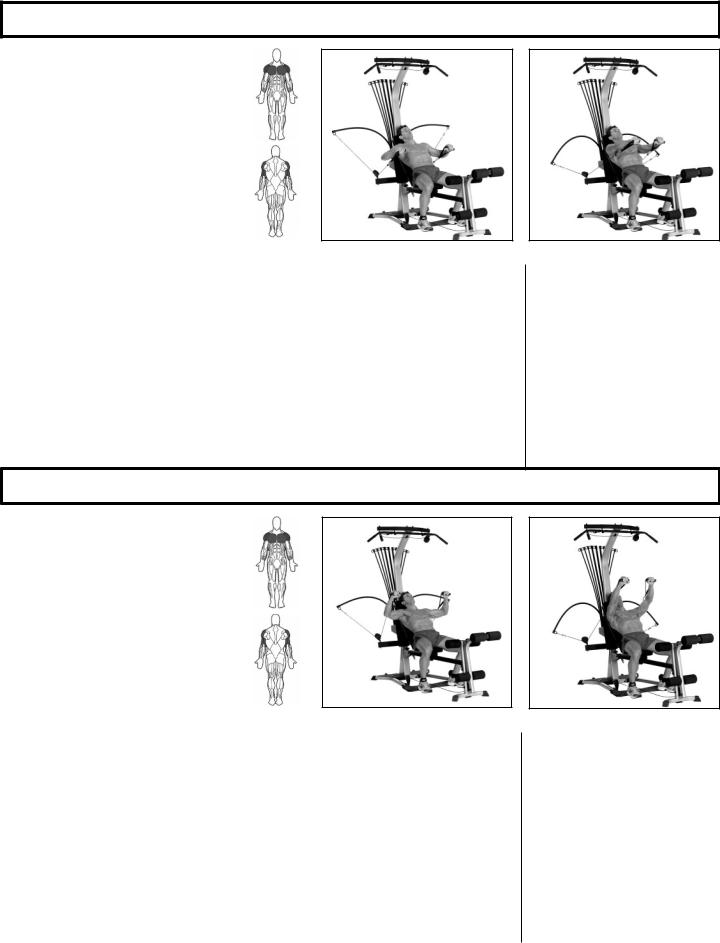
Chest Exercises
Decline Bench Press—Shoulder Horizontal Adduction (and elbow extension)
Muscles worked:
Pectoralis Major, Deltoids, and Triceps
Bench Position:
45o incline
Accessory:
Handgrips
Pulleys:
Chest Bar
SuccessTips
•Maintain a 90o angle between your
upper arms and torso at the start of the motion and slightly less than 90o at the finish.
•Keep your knees bent, feet on floor, and your head back against Bench.
•Do not let your elbows travel behind your shoulders.
•Keep your shoulder blades pinched together, and maintain good spinal alignment.
START
Start
•Grasp the Handgrips in both hands, cables travel beneath your arms, forearms aligned with cables.
•Bend your elbows back, keeping your forearms at a 90o angle
from your torso. Elbows should be 10o (5-6" or 13-15 cm) lower than the standard Bench Press position.
•Raise your chest, pinch shoulder blades together, and maintain a comfortable arch in lower back.
FINISH
Action
•Slowly press your hands forward, straightening your arms while moving your hands
to the center and downward, at least 10o below your shoulders. Do not lock your elbows.
•Slowly return to the starting position, keeping your wrists steady and your movements slow and controlled.
Incline Bench Press—Shoulder Horizontal Adduction (and elbow extension)
Muscles worked:
Pectoralis Major, Deltoids, and Triceps
Bench Position:
45o incline
Accessory:
Handgrips
Pulleys:
Chest Bar
SuccessTips
•Maintain a 90o angle between your
upper arms and torso at the start of the motion and slightly less than 90o at the finish.
•Keep your knees bent, feet on floor, and your head back against bench.
•Do not let your elbows travel behind your shoulders.
•Keep your shoulder blades pinched together, and maintain good spinal alignment.
START
Start
•Grasp the Handgrips in both hands.
•Cables travel above your forearms. Keep your forearms in line with the cables at all times.
•Bend your elbows back,
keeping your forearms at a 90o angle from your torso and forearms 10-15o (6-8" or 13-20 cm) higher than the Bench Press position.
•Raise your chest, pinch shoulder blades together, and maintain a slight arch in lower back.
FINISH
Action
•Slowly press your hands forward, straightening your arms and moving your hands to the
center and downward at least 10o above your shoulders.
•Slowly return to the Start position, keeping your wrists steady and your movements slow and controlled.
19
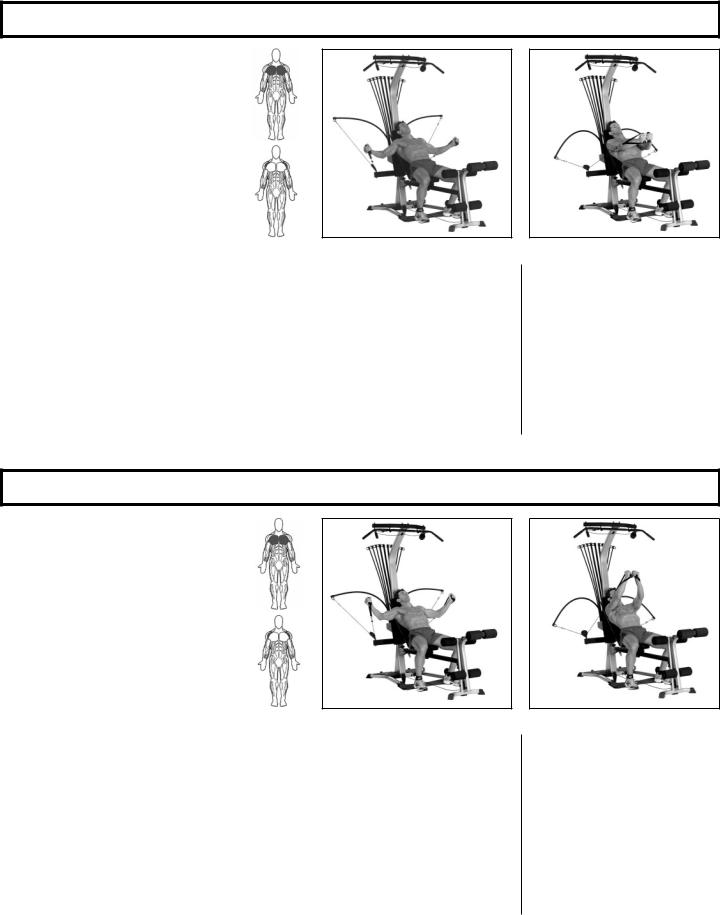
Chest Exercises
Decline Chest Fly—Shoulder Horizontal Adduction (elbow stabilized)
Muscles Worked:
Pectoralis Major and Anterior Deltoid
Bench Position:
45o incline
Accessory:
Handgrips
Pulleys:
Chest Bar
SuccessTips
•Maintain a 60-90o angle between your upper arms and torso during exercise.
•Keep your chest muscles tightened. Limit and control your range of motion.
•Keep your knees bent, feet on floor, and your head back against bench.
•To improve your pectoralis involvement, keep your shoulder blades pinched together throughout the upward and downward movements.
START
Start
•Grasp the Handgrips in both hands.
•Open your arms into a wide position while maintaining a bend in your elbows.
•Press your forearms downward. At full extension, your hands should be level with your hips.
•Raise your chest, pinch shoulder blades together, and maintain a slight, comfortable arch in lower back.
FINISH
Action
•Press your arms forward and upward, straightening your arms and moving your hands together.
•Return to the Start position, slowly returning your arms in front of you just below chest level.
Incline Chest Fly—Shoulder Horizontal Adduction (elbow stabilized)
Muscles Worked:
Pectoralis Major and Anterior Deltoid
Bench Position:
45o incline
Accessory:
Handgrips
Pulleys:
Chest Bar
SuccessTips
•Maintain a 60-90o angle between your upper arms and torso during exercise.
•Keep your chest muscles tightened. Limit and control your range of motion.
•Keep your knees bent, feet on floor, and your head back against the bench.
•To improve your pectoralis involvement, keep your shoulder blades pinched together throughout the upward and downward movements.
START
Start
•Grasp the Handgrips in both hands.
•Open your arms into a wide position while maintaining a bend in your elbows
•Press your forearms upward. At full extension, your elbows should be level with your ears.
•Raise your chest, pinch shoulder blades together, and maintain a slight, comfortable arch in lower back.
FINISH
Action
•Press your arms forward and upward, straightening your arms and moving your hands together.
•Return to the Start position, slowly returning your arms in front of you just below chest level.
20

Chest Exercises
Resisted Punch—Shoulder Flexion, Elbow Extension, Scapular Protraction
Muscles worked:
Anterior Deltoid and Triceps
Bench Position:
Horizontal
Accessory:
Handgrips
Pulleys:
Chest Bar
SuccessTips
•Maintain an upright, erect posture as your trunk rotates with the punch.
•Keep knees bent and feet on floor.
•Maintain good spinal alignment.
START
Start
•Sit on the bench, facing away from the Power Rod® unit.
•Reach behind your body and grasp the Handgrips with an overhand grip, as shown above.
•Bend your elbows until your hands are level with your waist.
FINISH
Action
•Using moderate speed, press your arm forward to full extension, allowing your shoulder blade to move forward at the end of the punch.
•Slowly return to the Start position without relaxing the tension in your arms.
•You may vary this exercise by using bilateral movement with both arms or punching upward or downward.
Lying Cable Crossover—Shoulder Extension/Adduction (elbow stabilized)
Muscles worked:
Pectoralis Major
Bench Position:
Horizontal
Accessory:
Handgrips
Pulleys:
Chest Bar
SuccessTips
•Keep chest lifted throughout exercise.
•Keep knees bent, feet on floor, and your head back against bench.
START
Start
•Lie flat on your back with
your head toward the Power Rod® unit.
•Position yourself far enough down the Bench to grasp the Handgrips over your head with your arms straight.
•Grasp the Handgrips, palms facing up.
•Tighten your abdominals to stabilize your spine. Maintain a slight, comfortable arch in lower back.
FINISH
Action
•Keeping your arms straight, move your hands in an arc upward and across your torso toward the opposite thigh.
•Control the return to the Start position by slowly moving your arms back overhead, releasing the shoulder blades and keeping your arms straight.
21

Shoulder Exercises
Rear Deltoid Rows—Shoulder Horizontal Abduction (and elbow flexion)
Muscles Worked:
Rear and Middle Deltoids, Posterior
Rotator Cuff, Upper Latissimus, Teres
Major, Trapezius, and Rhomboids
Bench Position:
Horizontal
Accessory:
Handgrips
Pulleys:
Chest Bar
SuccessTips
•Keep your knees bent and feet on floor.
•To work one arm at a time, place nonworking hand on the Bench to stabilize.
•Keep your shoulder blades pinched together and maintain good spinal alignment.
START
Start
•Sit on the Bench, facing the Power Rod® unit.
•Grasp the Handgrips with your opposite hands. Keep your palms down and arms straight.
•Sit up straight.
•Lift your chest, and keep your shoulder blades together.
•Keep your forearms in line with the cables.
FINISH
Action
•Allowing your arms to bend slowly, move your elbows out-
wards and backwards, keeping a 70-90o angle between your forearms and torso.
•Move until your elbows are slightly behind your shoulders, then slowly reverse back to the Start position.
•Keep your shoulder blades tightened throughout the motion.
Standing Lateral Shoulder Raise—Shoulder Extension (elbow stabilized)
Muscles Worked:
Middle Deltoids and Upper Trapezius
Bench Position:
Removed
Accessory:
Handgrips
Pulleys:
Chest Bar
SuccessTips
•Do not swing your arms upward or move your trunk during the motion.
•Keep your feet on floor.
START
Start
•Remove the Bench, straddle
the Seat Rail, and face the Power Rod® unit.
•Grasp the Handgrips, palms facing each other.
•Align your spine, and bend
forward slightly at your hips (15-20o).
•Let your arms hang in line with the cables.
•Elevate your shoulders slightly toward the back of your head, keeping your spine aligned.
FINISH
Action
•Slowly raise your arms out to your sides at a 90o angle from your body.
•Keep your forearms facing outward throughout the movement.
•Slowly return to the Start position without relaxing muscle tension.
22

Shoulder Exercises
Seated Shoulder Press—Shoulder Adduction (and elbow extension)
Muscles worked:
Front Deltoids, Upper Trapezius, and Triceps
Bench Position:
Horizontal
Accessory:
Handgrips
Pulleys:
Chest Bar
SuccessTips
•Keep your knees bent and feet on the floor.
•Do not increase the arch in your lower back as you raise your arms, but keep your spine steady and tight.
•Keep your abdominals tight, and maintain good spinal alignment.
START
Start
•Sit on the Bench, facing away from the Power Rod® unit.
•Keep your chest up, abs tight, and maintain a slight arch in your lower back.
•Grasp the Handgrips, palms facing out.
•Raise the Handgrips to shoulder level, keeping your palms facing forward.
FINISH
Action
•Straighten your arms slowly over your head, focusing on moving your elbows up and inward toward your ears.
•Slowly return to the Start position, keeping tension in your front shoulder muscles.
Front Shoulder Raise—Shoulder Flexion (elbow stabilized)
Muscles worked:
Front and Middle Deltoids
Bench Position:
Horizontal
Accessory:
Handgrips
Pulleys:
Chest Bar
SuccessTips
•Keep your abdominals tight, and maintain good spinal alignment.
•Keep your knees bent and feet on floor.
•Do not increase the arch in your lower back as you raise your arms, but keep your spine steady and tight.
START
Start
•Sit on the Bench, facing away from the Power Rod® unit.
•Keep your chest up, abs tight, and maintain a slight arch in your lower back.
•Grasp the Handgrips, palms facing back and arms straight at your sides.
FINISH
Action
•Keeping your arms straight, move them forward, leading with your forearms, until your arms are extended in front of you at shoulder height.
•Arms may be moved alternately or together.
•Slowly return to the Start position.
23

Shoulder Exercises
Shoulder Extension—(elbows stabilized)
Muscles Worked:
Latissimus Dorsi, Teres Major, Rear
Deltoid, Middle Trapezius, Rhomboids,
and Triceps
Bench Position:
Horizontal
Accessory:
Handgrips
Pulleys:
Chest Bar
SuccessTips
•Keep your knees bent and feet flat on the floor.
•Keep your lats tightened throughout the motion.
•Keep your abdominals tight, and maintain good spinal alignment.
•Release your shoulder blades at the end of each rep, and initiate new rep by retracting your shoulder blades.
START
Start
•Sit on the Bench, facing the Power Rod® unit.
•Grasp the Handgrips, palms
facing down, arms straight and at approximately a 45o angle from your torso.
•Tighten your trunk muscles to stabilize your spine while maintaining a slight arch in your lower back.
FINISH
Action
•Initiate movement by pinching your shoulder blades together.
•Continue the movement by moving your hands in an arc downward along your sides until your hands are level with your hips.
•With controlled movement, slowly return to the Start position.
Shoulder Shrug—Scapular Elevation
Muscles Worked:
Upper Trapezius
Bench Position:
Removed
Accessory:
Handgrips
Pulleys:
Chest Bar
SuccessTips
•Keep your abdominals tight, and maintain good spinal alignment.
•Do not bend your neck or slouch during this exercise.
•Raise your shoulders evenly.
•For variation, try this exercise bent forward slightly from the hips.
START
Start
•Straddle the Seat Rail, facing the Power Rod® unit.
•Reach down and grasp the Handgrips, palms facing each other.
•Let your arms hang at your sides.
FINISH
Action
•Slowly raise your shoulders toward the back of your head, keeping your neck and head still.
•Slowly reverse back to the Start position, keeping your upper trapezius muscles tight throughout the motion.
24
